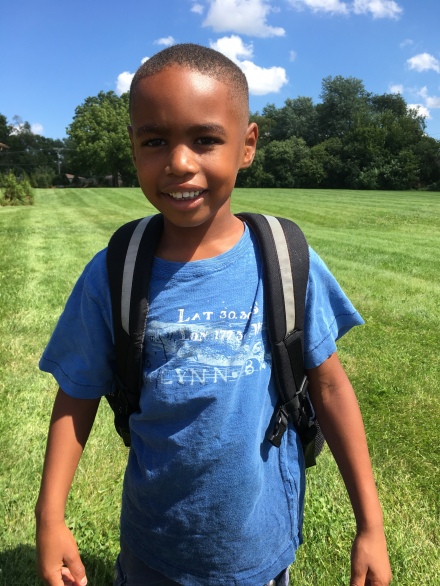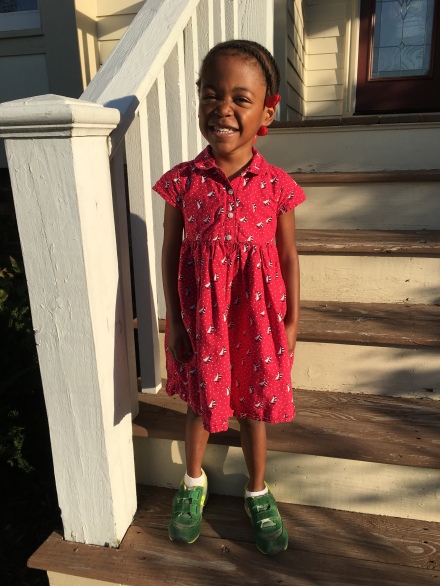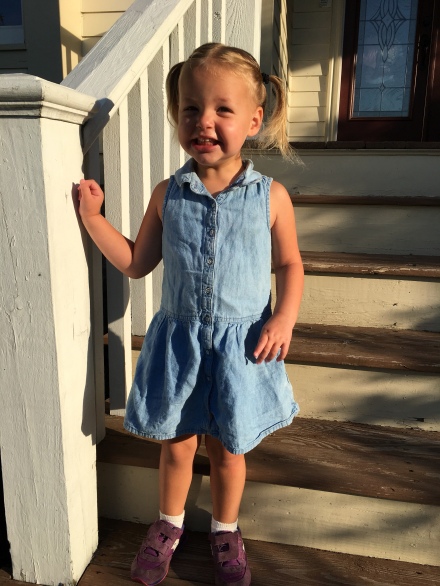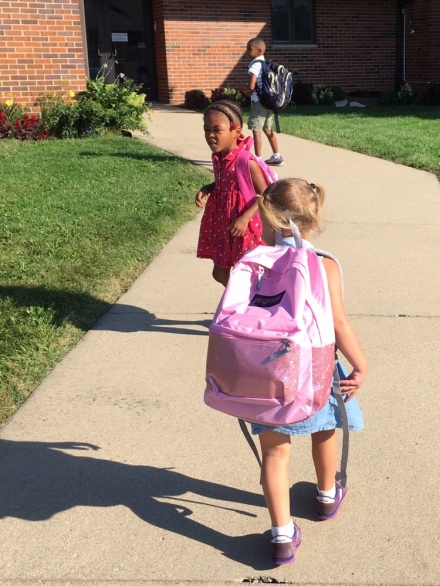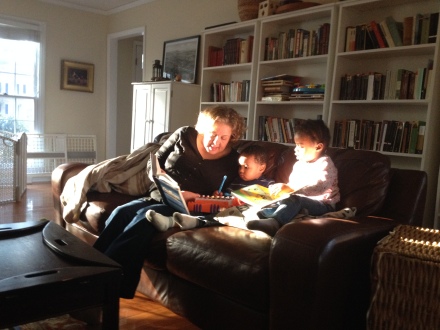Outside my window…

Sunshine is pouring down after a long stretch of cold gray days. [I wrote that two days ago. Now it’s gray and dreary, but at least it’s in the 50s]. We’ve had an odd winter with bitter cold and loads of snow in December followed by a snow-less January and February. Temperatures vacillated between frigid cold and balmy spring-like days. We even had a couple thunderstorms and a tornado watch in the mix. Flower buds popped out along the bare branches on our crap apples and daffodil shoots sprouted all over the yard. Now that it’s March we’ve had another four sticking snows and the kids finally got to use the sleds they received for Christmas. All the plants about to bloom have paused and hunkered back down looking a bit sheepish. If they had feelings I think they’d mirror the embarrassment one feels after standing up for a song in church, looking it up in the hymnal, then glancing around after finding the page to realize everyone else has remained seated. A purely hypothetical scenario not based on personal experience at all, of course. We moved into this house in June so I’m looking forward to seeing the yard in Spring for the first time.
I am thankful…

At the natural history museum. Only Josie seems to grasp the peril of their situation
…that the stomach flu continued on its way after afflicting only Jack. Poor Jack, but lucky us. [Update from two days later: apparently I jinxed myself. Reward: spending half last night up with a vomiting baby].
…for community. We’re glad to be closer to family but have badly missed our old neighborhood, friends, church, and military community in North Carolina. We’re finally starting to build a few connections after many months of church hunting and it’s a nice feeling.
…for bigger kids. This is the last day of The Man’s latest stretch of ICU call. ICU is still exhaustingl and intense on the home front, but so much easier than it used to be. The Man came home late in the evening yesterday, glanced around the tidied-right-before-bed-with-the-kids house, and commented “You know, the house could never have looked this good in the middle of an ICU week a year ago.” It’s true. 4, 4, 2, and 1 is a very different state than 3, 3, 1, and an infant. When he’s gone for extended stretches it’s still (very) hard work but I don’t constantly feel like I’m scrambling to keep body and soul together. There’s just enough breathing space for little extras like a museum trip, park stop, or store run with all four in tow. I even made it to church solo with all four little kids this morning – a first! They can do things now like eat a picnic lunch in the car with (reasonable) tidiness, skip the occasional nap or snack, or delay a meal half an hour without imploding. Altogether, just a little more flexibility in our days.
I am thinking…



about Spring plans outside and inside. Our home has basic landscaping but nothing more. We’d like to plant flower beds, a vegetable garden, some fruit trees, and a few berry bushes but will have to see what time allows. We’re also debating school plans for next year. Continue as we have with private school a couple mornings a week and low-key homeschooling on other days? Public special needs preschool? Full time homeschooling with more room for therapy? Another option?
Learning all the time…


with baking experiments. I love to cook and bake but can easily fall into a rut thanks to the basic necessity of feeding all these people all these meals on all the days. I really haven’t done much with yeast breads in the past. So, in place of the usual familiar dessert baking I’ve been experimenting this Lent with various yeast-based doughs: pizza dough, Smitten Kitchen’s Cheddar rolls (delicious, but I think better with tomato soup than for breakfast), and a couple batches of whole wheat/whole grain bread. Do you have a favorite recipe (or cookbook) for whole wheat bread, the perfect pizza dough, or something else? I’m all ears. We’ve had reasonable success but risen doughs are definitely a learned skill.
Celebrating the liturgical year…


with a low-key Lent. I can’t say we’ve done anything specifically Lenten as a family though we continue as usual with daily Bible reading, prayers, and hymns with the kids. As adults it’s been a quiet but beneficial Lent so far. Not dramatic, but steady. While it’s not specifically Lenten, I’ve also been enjoying richer and more consistent scripture study since Christmas. We’re pretty consistent about reading the Bible as a couple but I’ve struggled with sticking to my own devotions. I’m a fast reader and often find myself skimming through the Bible when I sit down to read it. On the other hand, when I use a formal study the intellectual perfectionist side of me rears its head and I find myself writing exhaustive answers to each question and lost for hours on a section that’s designed to take ten minutes. That’s not bad except that I then get impatient and frustrated and abandon the whole thing. At the end of December I jumped (late) on an Advent-focused scripture writing challenge. I started a new one in January and found I really benefited from the forced slow pace and intense focus of hand-writing a passage instead of just reading it. At the beginning of February I decided to start copying an entire book by hand. I settled on Romans because it’s middle-of-the-road in length, theologically rich, and one I haven’t studied in a while. Because I know myself and my tendency to do things just to check them off the list I didn’t even break it into sections to tackle and check off. Every morning I just read the next passage (usually 3-6 verses), hand copy it, re-read it, then rapidly skim the book back up to that point to place it in context and make sure I’m tracking. I’m happy to say, after years of on-again-of-again personal study that I’ve missed only a couple of days since January first. I’m half way through Romans and am pausing to outline the first eight chapters and review. 6 weeks sounds like a long time for eight chapters but I’m flying compared to my childhood pastor who preached through Romans for two straight years. There really is such a thing as too much of a good thing.
From the kitchen…


as mentioned above, yeast breads. Also, a fair number of meatless meals like potato pancakes, leek and potato soup, salads, black beans, and pasta. I also made crepes for the first time using the Joy of Cooking recipe. I substituted 1/3 whole wheat flour for all purpose. My Mom used to make crepes and I love them so I don’t know why it took me so long to get on the bandwagon. They make a nice Lenten special family breakfast. I skipped the sugar in the batter, spooned warm applesauce down the middle, rolled them up, and sprinkled cinnamon on top. A hit with everyone. Were it not Lent that’d be cinnamon sugar, the way my Mom used to make them for us on cold winter mornings. After Easter there’ll be blintzes and crepes with Nutella and strawberries in our treats lineup.
I am creating…

a scarf. Very. Very. Very. Sloooowly. At this rate it will be ready just in time for the stifling heat of August. Knitting is not a “just like riding a bike” skill for me. I’ve learned and then forgotten how to knit many times: as a small child, an older child, in college, and again while The Man was deployed. At some point after the twins became mobile one crawled to the knitting basket and tangled my work-in-progress. I never finished it. Two more babies followed and all skills were again forgotten. I’m just now getting to the point where there’s a smidgen of breathing room for handcrafts. Courtesy of YouTube I’m now back to knitting Continental Style. I’m making this pattern without the contrasting center stripe or letters.
I am working on…

bits of spring cleaning, as time allows.
I am going…

to lots and lots of therapy appointments. Physical therapy for me, feeding therapy for Jenny (the end is in sight after almost three years!), Speech, OT, and Behavioral Therapy for Annie. In addition there are specialist visits for various children and routine pediatrician and dental checkups needed. I don’t really like being a family that has someplace to be every day of the week but right now it’s necessary. Whenever possible I treat appointments as special 0ne-on-one time with a child. We chat in the car, play music of the kid’s choice, and read books or play one-on-one together in the waiting room. Often the long drives are also a good time for me to catch up on my podcasts queue or listen to an audiobook if the child isn’t in a chatty mood.
I am hoping…

to prepare well in advance for a weekend trip to New York. Practically, though, who am I kidding ;).
I am praying…

for our three older kids and their first families. Adoption is complicated and messy. A blessing, yes, but also a tremendous loss.
I am pondering…

Jack’s face of concentration. Ha!

special needs parenting. I’m reading as much as I can get my hands on. There’s a wealth of (often contradictory) information out there. It’s hard to take that flood of information in, filter it, and decide what’s best for a child who doesn’t yet have much say. Unfortunately many Christian parenting books take a one-size-fits-all approach to parenting that may work with typically developing children but is poorly suited to kids with neurological differences. It’s humbling as a parent who thought I knew everything before having kids (and frequently judged others’ parenting) to realize that much of our kids’ behavior and growth cannot, and sometimes should not, be controlled by us. It’s a constant fight to focus on what a child really needs and not the way others around us are judging the child or our parenting.
I am reading…

Travels with Charley by John Steinbeck as an audiobook read by Gary Sinise. It’s wonderful, and Sinise has the perfect voice for it. Even if you’re not a Steinbeck fan I highly recommend this account of his casual journey through 40 states. He combines dry wit and poetic description with detached observation and a warm interest in the people he meets. I love a good armchair travel book but frequently cringe at travel writer’s scornful summary of the people they encounter. I can’t imagine how the people Bill Bryson or Paul Theroux describe must feel at the authors’ sardonic assessments of their lives. Steinbeck manages to describe foibles without mockery and approaches others on his travels with warm interest. I’m also reading Madeleine L’Engle’s first memoir A Circle of Quiet which is enjoyable and thought provoking. She’s incredibly well-read so each page brings up some other book I should also read. Dangerous fodder.
I am listening to…

Podcasts, whenever I can. When I was growing up my parents frequently had the radio on. Classical music, talk radio, or the news in the car, often Old Time Radio or Car Talk on Saturday mornings. I almost never turn the radio on but I think Podcasts are my equivalent. It’s nice to have a grownup talking to me about something interesting as I do the dishes or fold laundry. We’re also listening to classical music quite a bit as the kids usually request “singing” in the car and one can tolerate only so much of Elizabeth Mitchell or the OkeeDokee Brothers. Right now it’s Haydn’s masses in the car and Beethoven in the CD player at home.
I am hearing…

The washing machine gently swishing, laundry tumbling ’round the drying, and an anemic burbling from our increasingly useless coffee maker. The baby spent half the night vomiting through multiple rooms so I’m in wash-and-sterilize-everything mode.
I am struggling…

with my hair. Which sounds a bit silly and vain but I’ve never been a hair or makeup person. All my life I’ve just washed every couple days, combed or brushed, and tossed it back in a bun, braid, or ponytail without blow drying, styling, or products. The very hard water in our new home is wreaking havoc on my hair though and it constantly looks unkempt. Dry strands, frizz, and unevenness abound. The hard water doesn’t really bother us in any other way so I’m wondering if there are better product choices vs. investing vast sums in a water softener.
Clicking around…

Well, not much really. I’m doing my best to cut back on social media in particular and screen time in general. Which, bonus, allows time for things like writing and reading!
Around the house…

SuperDad comforts four fussing children at once.
we’re making plans for painting a few rooms. We haven’t made any changes to the house and have only hung one picture since we moved in Hopefully we can get a few small projects done before warmer temperatures pull our living outside. We’re adding in some more consistent chores for the big kids now that they’re four. We’ve always had them help, but are adding in a few more regular jobs at regular times for them like vacuuming the dining room after meals and a set whole house cleanup every evening. They’re still at the age where it’s more work to supervise them than to do it ourselves, but it’ll be worth it in the long run.
One of my favorite things…

The quiet hour or two before the kids get up. I’ve been consistently getting up at 5:00 or 5:30 since New Years with only a couple of later days from illness or missed alarms. I consider the earliest hours my personal time. For this introvert it’s a key window to read, eat a quiet breakfast, do my Bible study, exercise, or knit. Sometimes I squeeze in a chore or two, but I don’t feel obligated to use that time for household purposes. I find when I start the day with something mentally fulfilling I’m a much better spouse and parent throughout the day.
A few plans for this week…

About typical for our “selfies for six” attempts. Seven if your count Annie’s beloved bear.
Therapies and specialist appointments. Dinner with the pastor’s family tonight. Sending off picture and email updates to the kids’ birth families.
A little peek at my day…

A sick baby overnight means a freshly-bathed baby with fabulous hair in the morning.
